What you'll learn inside — How to Grow Sweet Peas:
- Sweet Pea Species
- Starting Sweet Peas
- Preparing to Plant
- Planting Methods
- Caring for Sweet Peas
- Harvesting Tips
- Dealing with Pests
- Harvesting Seeds

Sweet Pea Species Types
01. SPENCER SWEET PEAS
- 90% of species out there are Spencer
- Large, ruffled flowers
- Between 3-5 flowers per stem
- Require 12 hours of sun to induce bloom cycle
02. GRANDIFLORA SWEET PEAS
- Smaller flowers; shorter stems
- Not as ruffly, but produce tons of blooms
- This variety is very scented; it has the classic “sweet pea scent”
- Old Times; Almost Black
- Excellent for garden flowers or paired with vegetable gardens; not necessarily great for cut flowers
- Also require 12 hours of sunlight to induce bloom cycle
03. SEMI-GRANDIFLORA SWEET PEAS
- Between grandiflora and Spencer
- Lots of scent and lots of blooms
- common types (very highly scented)
- High Scent
- Shorter stems, so good for garden flowers
- 12 hours of sunlight needed for bloom
04. EARLY MULTIIFLORA SWEET PEAS
- Series
- Solstice (different colors in the series)
- Mammoth (different colors in the series)
- Sunshine (different colors in the series)
- Winter elegance (different colors in the series)
- Only require 10 hours of sunlight to induce bloom cycle; will always bloom first in your patch
- Very long stems; great for cutting
- Excellent for a hot environment, but need to fall-sow them

Sowing Sweet Peas
When to sow sweet peas
ZONES 7-10
- Autumn sow
- October-November
- Keep them cool when they’re germinating; excess heat will make the stems long and lanky
ZONES 5-7
- Autumn or early spring sow
- May need some protection for super cold temps
ZONES 3-5
- Start in late winter

General Sweet Pea sowing notes:
DON'T SOAK!
- Not necessary to pre-soak
- This doesn’t actually speed up germination but instead introduces bacteria
COMMON MISTAKES:
- Too warm
- Too dark
- Leggy seedlings
- Leaning seedlings
Direct Sowing
- Can be done but often get eaten by pests
- Can also rot easily in wet climates
- If you can monitor the environment, it’s okay to direct sow
Other Do's and Don'ts of Sowing Sweet Peas
- The deeper the tray, the better
- Root trainers or 50 cell trays are best
- Need good starting mix (like Pro Mix
- Don’t push the seed to the bottom of the cell; maybe aninch deep
- Water and wait; they will germinate in 10-14 days
- If it’s too hot, they’ll germinate sooner, but this will cause lankiness
- Will germinate in 50-55 degrees; they like it cool
- Cell walls are stronger if they are grown cold
- You want short, beefy seedlings rather than long, leggy ones
DON'TS
- Don’t bottom-water! Always overhead water to prevent rot
- Don’t use a heat mat
As soon as the seedling heads appear, put them under grow lights or natural light (like a greenhouse).
Pinching Sweet Peas
Overwintered and fall-sown plants don’t need to be pinched–they will branch naturally
Spring-sown plants will need to be pinched; pinch after second set of leaves
After they are pinched, they can be planted.

Preparing to Plant
PREPPING THE BEDS
Location
- Morning sun and afternoon shade is great
- Prepare for height with a fence, arbor, etc.
Soil
- Load up the soil with compost (mushrooms are a good sign)
- Don’t use hot compost for planting–just for prepping
Support
- Start tall
- Can use rebar plus netting
- Can use fencing, trellis, etc.
- At the farm, they use 10 foot rebar and 8 foot-long Hortonova netting per rebar
Netting
- Don’t use small netting–sweet peas can’t weave through it. Use something substantial because sweet peas are so heavy
- Hortanova netting is good because of the strength and size of the squares
Planting Sweet Peas: Distance Apart
- For seed production, 4-6 inches works (for air flow)
- For cut flowers, very close (1-2 inches) is okay; it will create a “green wall”
- Plant very close to the netting (within two inches)
- A “trench” system works much better and is easier than individual holes because of the spacing of the plants
Feeding the Plants
- For both methods, dig deeper than you have to–at least 8 inches
- Add cool (not hot!) compost to the bottom
- Add dirt on top
- Add plant on top
- This “lasagna” method gives food to the sweet peas

Once your Sweet Peas Are Growing
COMPOST TEA
When they are about a foot tall, spray with compost tea
General Compost Tea Recipe
- 5-gallon bucket
- Dr. Bu’s compost bags
- Put in bucket; sit for 8 hours
- Squeeze out
- Before spraying, add liquid kelp and fish fertilizer (a “couple of glugs” worth)
- Add to backpack sprayer or watering can; light mist on plant and/or ground. Spray shouldn’t sit and pool on leaves.
Don’t spray in the heat of the day! Before bed, in the evening is best. Spray every week-and-a-half to two weeks. Stop spraying when you see buds starting to form (you will lose the first flush of flowers); spraying is done for the season.
Tying, Coralling and Creating Long Stems
- Use twist tie or tie wire to attach to netting (not necessary but helps with long stems)
- Can also use other methods to corral (twine, etc)
- Tie as often as needed to keep them tall and taut
- If you’re growing just for the garden, you can let them grow crazy; if you want long stems for cutting, they need to be tied
Dealing with Pests in your Sweet Peas
APHIDS
At their starting stage, they look like a stick film on your plants
Solutions:
- Companion planting works great
- Alliums, garlic, marigolds
- “Bug Buster” spray as needed
- If you need to use spray, use it at night and very lightly (sweet peas don’t like to be sprayed)
VIRUS
Mosaic virus
- Doesn’t transfer to the seed, but spreads from plant to plant very quickly
- Leaves will start to bubble and contort; can produce spotty, yellow leaves
- Flowers get streaky and spotty
Solutions
Immediately pull out the infected plant(s)

Harvesting Sweet Peas
- Harvest when there are 2-3 buds per stem (if you’re growing for cut flowers)
- Cut them in the coolest part of the day
- Flower food isn’t necessary
- Vase life is 3-5 days. To extend their vase life, put them in the fridge at the end of the day
- Keep cutting them to keep them from setting seed
- Sweet peas will shut down at 80 degrees and start setting seed.
Harvesting Seeds
- Each seed pod will have around 5 seeds
- Look for brown and dry seed pods (outside should sound like sandpaper)
- The seeds you are harvesting should be all brown, no green remaining
- Can be harvested with brown or lunch bags (not plastic–needs to breathe); label the bags and fill with seed. Bags can be stored until winter as long as they’re dry. When ready, you can hand-shuck them or seeds will often explode on their own (leave the bag closed!)
- Seeds are “true”; they don’t cross- pollinate but will be the copy of the original plant
TOP TIPS for GROWING SWEET PEAS
✓ Location, location, location
✓ Protect them from wind
✓ Morning sun
✓ Water every day
✓ Compost
✓ Pre-planting
✓ Compost tea when growing (pre-flowering)
✓ Prefer cool weather - they can handle down to single digits; at that point, you would want to cover them


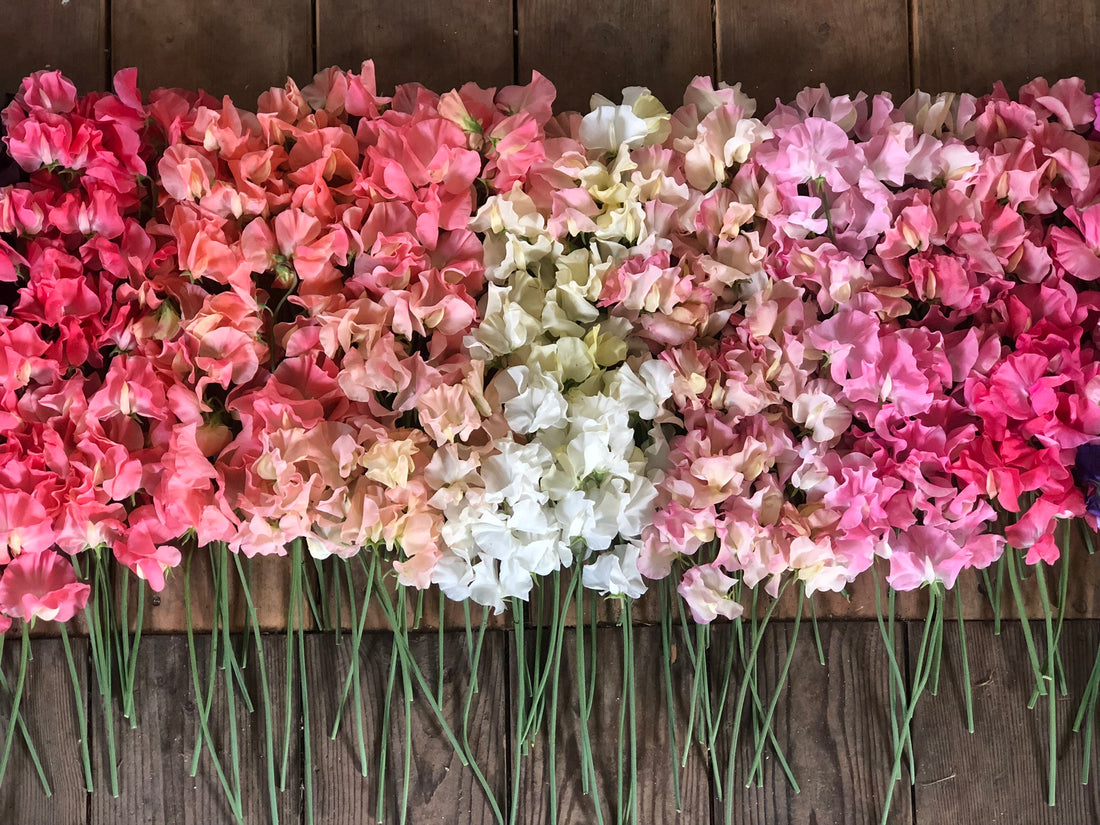



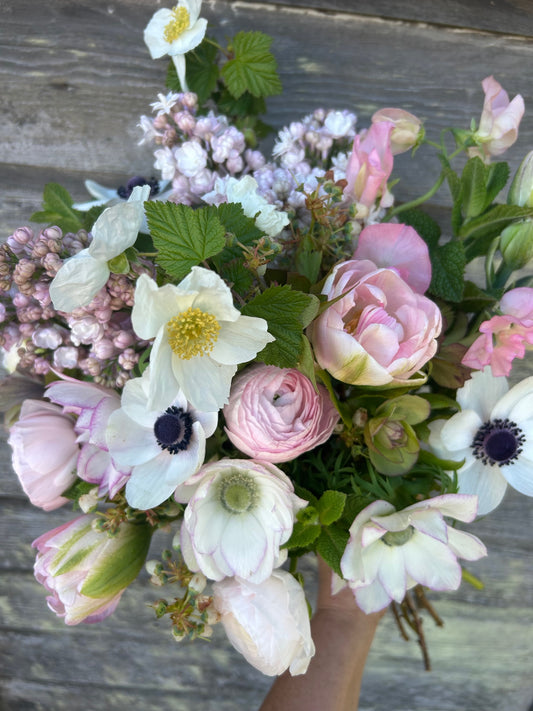
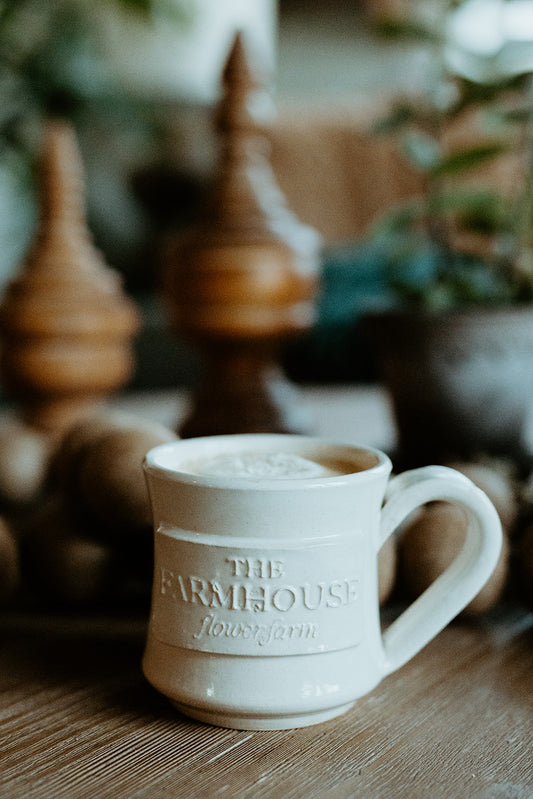
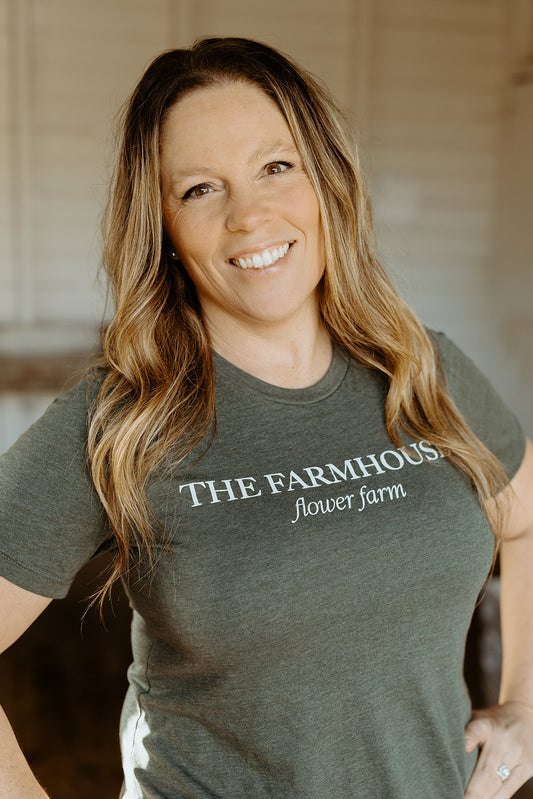
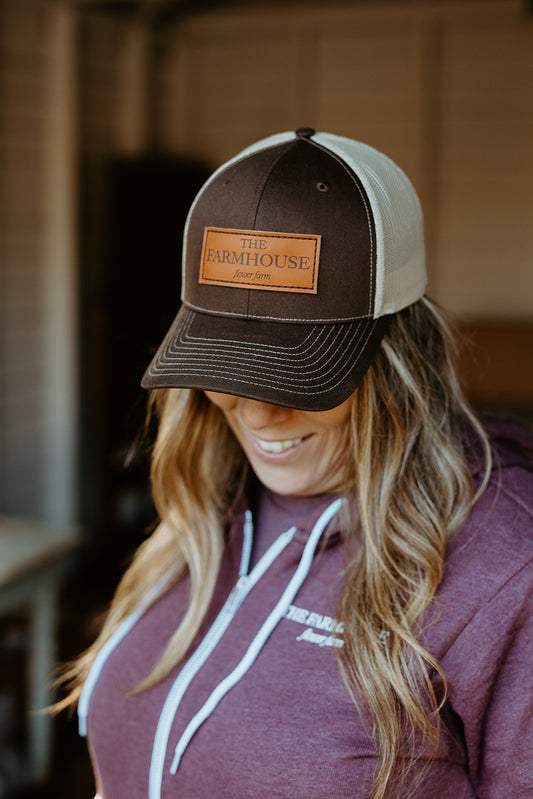
10 comments
Love your website!! I’m so excited for this year’s growing season. Thank you for all the beautiful inspiration and knowledge.
I have never known that that there are different types of sweet peas! Would the classification be on the seed pack somewhere? Maybe that’s the reason that I don’t get the arm full of flowers that I’m dreaming of! Thank you! And thank you for having all of this information so easy to access!
2 years ago I had never successfully grown Sweet Peas. Took your online class and ordered seeds that very day. I am in the 3rd season of loving growing them now. Thank you Marryn for breaking it down and building my knowledge, confidence and love for growing these amazing beauties!!! This post of the “Cliff notes” of your method is just icing on the cake. The blessings just keep coming. May you have another abundantly blessing growing season .. thanks again.
Thank you for this tutorial! So glad I don’t need to soak the seeds first…big time-saver.
Have a sweet spring!
Tracey
I tossed a handful of sweet pea seeds on the side of my house last fall. I thought a freeze had killed them, but they are coming back. I don’t expect much – I think it will get hot before they bloom – but I’m excited to try some again the fall.
Thanks for the demystification!
Amanda